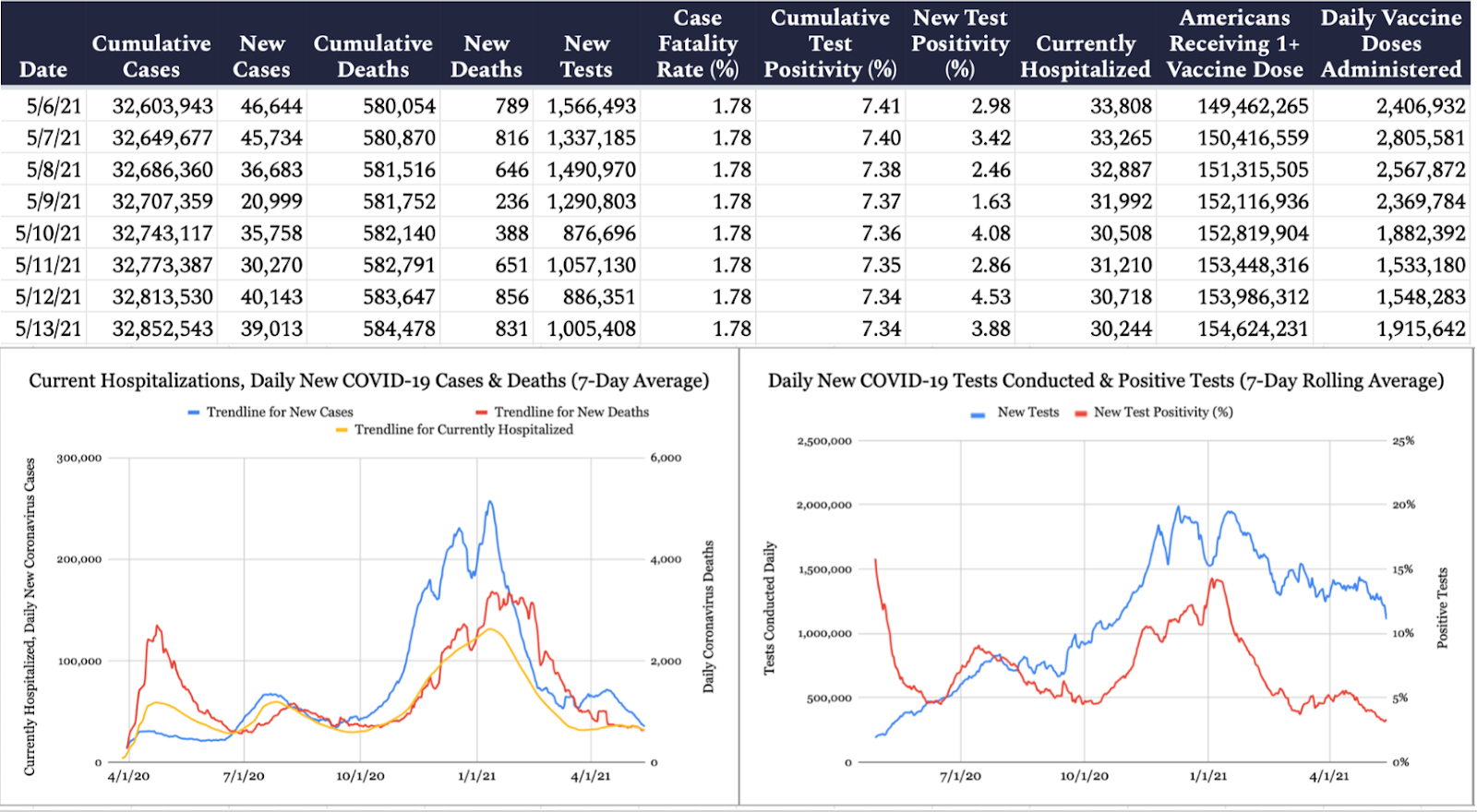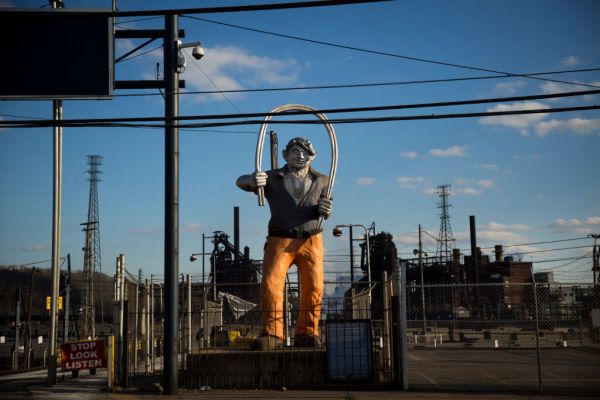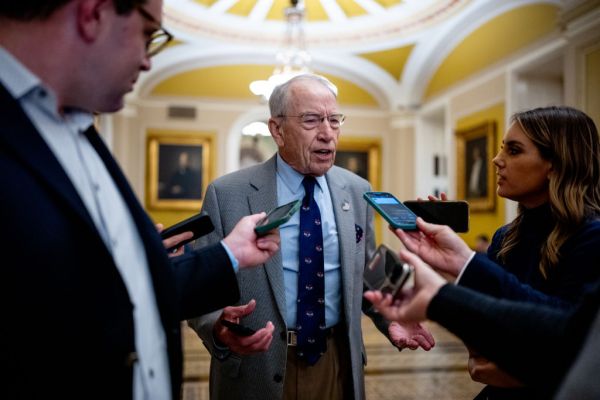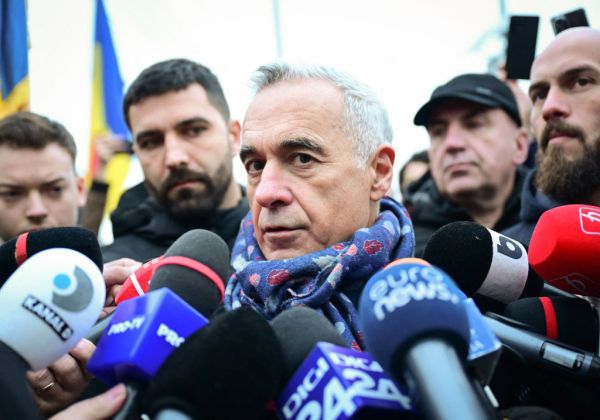Happy Friday! We wished you a happy Wednesday yesterday in error, but we triple-checked this morning, and you can rest assured that today is indeed Friday. You won’t be hearing from us for a few days.
Quick Hits: Today’s Top Stories
-
The Centers for Disease Control issued new guidance for fully vaccinated people yesterday, saying those two weeks past their final COVID-19 vaccine dose can “resume activities that you did prior to the pandemic … without wearing a mask or staying 6 feet apart” in most indoor and outdoor settings. Americans will still be required to wear masks on planes, buses, and trains, however.
-
Bloomberg News reported Thursday that Colonial Pipeline paid nearly $5 million in ransom money last week to the DarkSide hackers that infiltrated the company’s systems. Asked if he was briefed on such a payment, President Joe Biden said he had “no comment on that.” Colonial had said earlier this week it resumed most operations on Wednesday evening.
-
Initial jobless claims decreased by 34,000 week-over-week to 473,000 last week, the Labor Department reported on Thursday, the lowest level since March 14, 2020.
-
Rep. Chip Roy of Texas announced yesterday he will run against Rep. Elise Stefanik in the race to succeed Rep. Liz Cheney as House GOP conference chair. Republicans are expected to vote this morning, and Stefanik—having received backing from former President Donald Trump—is the clear favorite.
-
Politico reported yesterday that an independent government watchdog concluded that Housing and Urban Development Secretary Marcia Fudge violated the Hatch Act earlier this year when she weighed in on a 2022 U.S. Senate race.
-
The United States confirmed 39,013 new cases of COVID-19 yesterday per the Johns Hopkins University COVID-19 Dashboard, with 3.9 percent of the 1,005,408 tests reported coming back positive. An additional 831 deaths were attributed to the virus on Thursday, bringing the pandemic’s American death toll to 584,478. According to the Centers for Disease Control, 30,244 Americans are currently hospitalized with COVID-19. Meanwhile, 1,915,642 COVID-19 vaccine doses were administered yesterday, with 154,624,231 Americans having now received at least one dose.

What to Do About Federal Unemployment Insurance?
As the vaccines continue their march across the land, with roughly 2 million Americans getting the jab each day, it’s clearer than ever that we’ve reached the end of the total-war phase of the COVID-19 pandemic. The CDC’s latest guidance on indoor and outdoor mask-wearing means that even the most safety-conscious Americans will begin tiptoeing back into “normal” life, making the primary question not whether the U.S. economy will come back online, but how soon.
A growing chorus of voices, however, are warning that even as the viral threat wanes, artificial barriers are hampering America’s ability to get back to work. Initial jobless claims are the lowest they’ve been since the start of the pandemic, but unemployment remains stubbornly high—a fact attributable in part to the federal government’s ongoing payout of expanded unemployment insurance at the same level as competitive wages in many states, which is not set to expire until September.
Last month’s jobs report did little to quell these concerns. After analysts had predicted that the economy would create 1 million jobs in April, the Labor Department reported last Friday that nonfarm payrolls increased by a mere 266,000 jobs last month. Meanwhile, the unemployment rate slid up to 6.1 percent.
Since then, the Biden administration has taken pains to convince the American public that the latest jobs report is just a snapshot in time. “I know there’s been a lot of discussion since Friday’s report that people are being paid to stay home rather than go to work,” the president said on Monday. “Well, we don’t see much evidence of that.”
Yet that same day, the White House announced a series of initiatives to “help Americans return to work.”
“We’re going to make it clear that anyone collecting unemployment who is offered a suitable job must take the job or lose their unemployment benefits,” Biden said. “There are a few COVID-19-related exceptions so that people aren’t forced to choose between their basic safety and a paycheck, but, otherwise, that’s the law.”
Republican policymakers at both the federal and state levels are weighing in too. GOP Sen. Ben Sasse of Nebraska said this week he would introduce legislation enabling any current beneficiary of federal unemployment who gets a job by July 4, 2021 to receive two extra months of the payments as a “signing bonus.” Sasse characterized this plan as being both “pro-worker” and “pro-recovery.”
A spokesman for Sasse told The Dispatch yesterday that “Sasse’s preference had been to cap UI at 100 percent of wages” to avoid this problem in the first place; indeed, he and a few other Republicans briefly held up passage of the CARES Act over the provision last year. But with the GOP now in the minority, “converting the existing benefit to a limited-duration bonus is a politically viable option,” the spokesman added.
Republican governors in 12 other states have introduced similar plans, cutting federal unemployment insurance in hopes of propping up the labor supply for businesses who are in desperate need of workers.
On May 4, Republican Gov. Greg Gianforte announced that Montana would become the first state to opt out of federal unemployment benefits. “We need to incentivize Montanans to reenter the workforce,” said Gianforte, who has launched a return-to-work bonus program that plans to use funds from the latest COVID-19 stimulus package.
Arizona Gov. Doug Ducey announced yesterday he will implement a comparable policy. Arizonans who leave the UI program and return to work will, at the 10-week mark, receive a $2,000 “Back To Work bonus” if they get a full-time job, and a $1,000 one if they return part-time. Any worker who gets a job by Labor Day that pays less than $25 per hour is eligible.
To pay for it, Ducey is reallocating $300 million of the federal funds granted to Arizona for unemployment benefits. “In Arizona,” he said in a statement, “we’re going to use federal money to encourage people to work … instead of paying people not to work.”
How the Latest Violence in Israel Began
We sent you nearly 1,000 words on the situation in Israel earlier this week, but so much has happened since then that Charlotte had to write 2,000 more.
In a piece for the site today, she takes a look at the escalating violence, its myriad causes, and what comes next.
Here’s a 10,000-foot view of the situation.
As cross-border rocket fire between Israel and Gaza intensifies, families across Israel are becoming full-time occupants of their home, apartment, and neighborhood bomb shelters.
“The past several days have been especially challenging as a parent, in having to answer difficult questions posed by our 6-year-old daughter,” Adam Levick, who lives with his wife and two young children in Modi’in, told The Dispatch after Tuesday night’s attacks. “Though they’ve prepared her at school to some degree, we had to carefully explain to her, in language she would understand, but not language that would scare her, that there are people who want to hurt us, but that we’ll be safe in the shelter, and that our army—a word she likely doesn’t fully understand—and God—a word she does understand, as we are religiously observant—are protecting us.”
Modi’in—along with other cities across central Israel—has come under unprecedented rocket fire in the past several days, as Hamas unleashes its artillery on heavily populated civilian areas in retaliation for recent Arab-Jewish skirmishes in the Israeli capital of Jerusalem.
Before foreboding U.N. warnings of “full-scale war,” Amos Giland—a former Israeli defense official—described the lead-up to the conflict as a “powder keg” primed to “explode at any time” with prescient accuracy early this week. On Monday morning, a clash between police and Palestinians left more than 500 participants—mostly Muslim—wounded in the capital’s holiest site. By Monday evening, Hamas militants based in the Gaza Strip had retaliated with more than 450 rockets aimed at cities across Israel.
The Israeli Defense Forces (IDF) hit back in a series of targeted strikes the same night, setting off an aerial fight with alarming casualties on both sides. Early morning Friday, Israeli ground forces—including troops, artillery, and tanks—had amassed the border to Gaza. But despite contradictory statements from Israel’s military and premature reports from the media, no ground offensive has been launched into the territory as of yet.
According to the Gaza-based Palestinian Ministry of Health (a source that analysts have rightly cautioned should be taken with a grain of salt), at least 109 Gazans have been killed since Monday, including 28 children. Six Israelis, including a 6-year-old boy, have also been killed.
There’s an incredibly complex set of factors at play here.
Depending on who you ask, this recent uptick in violence is rooted in several points of local tension. Many point to the Israeli government’s impending eviction of six Palestinian families from residences in East Jerusalem’s Sheikh Jarrah neighborhood, an ongoing legal battle with dubious claims on both sides, as the source of this most recent conflict. Protests and rioting among the city’s Palestinian population broke out around the start of Ramadan last month, and persist even as Israel’s Supreme Court moved to postpone the verdict Sunday.
On Monday, crowds of Israelis gathered for an annual celebration marking the reunification of Jerusalem following the 1967 Six-Day War, when Israel preempted an invasion from its Arab neighbors and multiplied its territory over the course of less than a week. The parade typically passes through Damascus Gate, a flash point of recent fighting, but diverted to avoid direct confrontation. Several media outlets have described the holiday as a “provocation.”
But other analysts say Jerusalem is a lightning rod, emotionally charged enough to spark conflict but ultimately a pretense for Hamas to assert its dominance amid deteriorating domestic power. Late last month, Palestinian Authority President Mahmoud Abbas canceled the first parliamentary elections to be held since 2006 as Hamas and splinter factions of Fatah threatened to strip his party of its majority.
“Hamas was slated to take part in those elections and was likely going to win a fair number of seats, if not a majority. In the end Abbas was persuaded to cancel those elections, leaving Hamas with little recourse in terms of its ability to garner additional political support,” Jonathan Schanzer, senior vice president of the Foundation for Defense of Democracies and author of “Hamas vs Fatah,” told The Dispatch. “In many ways this current round of conflict strikes me as an attempt by Hamas to regain primacy in the Palestinian political arena.”
“They’re trying to make a major bid to become the dominant force within the Palestinian national movement. Without a doubt,” Aaron David Miller, a senior fellow at the Carnegie Endowment for International Peace, added. “Abbas is in the 16th year of his four-year term, he’s lost credibility as a consequence of cancelling elections.”
What happens next?
Speaking to Army Radio Tuesday, an IDF spokesman said the military has “not ruled out” a ground operation if violence persists. Thursday, Israeli Defense Minister Benny Gantz approved the call-up of 9,000 reserve soldiers. Such a move would be costly to both sides, onlookers warn, pointing to the 2014 Gaza War that left at least 2,200 Palestinians and 73 Israelis dead.
Some analysts are confident that the cross-border fighting won’t escalate to a full-scale intervention. “Netanyahu—despite his reputation—is actually a very cautious political leader when it comes to military activity. Putting troops on the ground is a major step and one that will imperil Israeli lives,” Schanzer explained. “I think the Israelis would much prefer a battle from the air.”
But unrest brewing within Israel proper may pose an even greater strategic threat than outside forces. Across the nation, clashes between religious factions in Jewish-Arab cities and towns have grown more destructive by the day. In Lod, a mixed city that once touted its coexistence, Arab mobs attacked Jewish-owned residences, a school, synagogue, and city hall in what one Jewish resident described as “like Kristallnacht.” The same night, an Arab Israeli man was shot and killed—and two others were wounded—by a Jewish suspect claiming self defense.
How is the Biden administration approaching all of this?
The Biden administration has also faced backlash for its handling of the crisis, which thus far has followed the American line of support for Israel’s right to self defense. “There is a very clear and absolute distinction between the terrorist organization Hamas that is indiscriminately raining down rockets targeting civilians, and Israel’s response defending itself, targeting the terrorists raining down rockets on Israel,” Secretary of State Antony Blinken said during a press briefing.
According to a White House readout of a call between Biden and Netanyahu Wednesday, the president conveyed “his unwavering support for Israel’s security and for Israel’s legitimate right to defend itself and its people, while protecting civilians.”
But to Schanzer, the niceties between the U.S. and Israel overlook “the elephant in the room”: Iran’s invariable role in the violence. “There has been a shadow war between Israel and Iran for the last several months. And it has been more intense than previously understood. Israel has struck Iranian assets in Syria, in cyberspace, on the high seas—and it has done so with relative impunity,” he explained. “It is my strong sense the Hamas attacks right now against Israel are being done with guidance and assistance from Iran.”
Worth Your Time
-
We’re pretty sure we’ve never mentioned Rebekah Jones in this newsletter, and that was intentional: Her conspiratorial claims about Florida cooking the books to downplay its COVID-19 situation were farcical, and we didn’t want to elevate them beyond the Resistance Twitter fever swamp. But her theories caught on in certain pockets of the left, in large part because they painted GOP Gov. Ron DeSantis as a ruthless monster. Charles Cooke eviscerates the whole saga in a comprehensive piece for National Review. “There is an extremely good reason that nobody in the Florida Department of Health has sided with Jones,” he writes. “It’s the same reason that there has been no devastating New York Times exposé about Florida’s ‘real’ numbers. That reason? There is simply no story here.”
-
Ezra Klein wants us to talk more about UFOs. There’s been an uptick in stories about potential sightings, and former high-ranking intelligence officials have repeatedly hinted at there being pertinent information to which the public is not privy. “All this is a little weird,” he writes. “None of it is proof of extraterrestrial visitation, of course. … The way I’ve framed the thought experiment in recent conversations is this: Imagine, tomorrow, an alien craft crashed down in Oregon. There are no life-forms in it. It’s effectively a drone. But it’s undeniably extraterrestrial in origin. So we are faced with the knowledge that we’re not alone, that we are perhaps being watched, and we have no way to make contact. How does that change human culture and society?”
Presented Without Comment
Also Presented Without Comment
Also Also Presented Without Comment
Toeing the Company Line
-
Atlantic reporter McKay Coppins joined David and Sarah on yesterday’s Advisory Opinions to chat about his recent profile of Brett Kavanaugh, which tracks the Supreme Court justice’s journey from his contentious 2018 Senate confirmation hearings to the bench. Plus: A discussion of a federal judge’s decision to dismiss the National Rifle Association’s bankruptcy case, the Facebook Oversight Board’s decision to uphold the platform’s ban on Donald Trump, and lower level judicial confirmation hearings.
-
Historian Niall Ferguson joined Jonah on The Remnant yesterday to talk about his new book: Doom: The Politics of Catastrophe. The pair discuss the human tendency to prepare for one disaster scenario while another hits us square in the jaw, the reason “we may be forced by companies to do Zoom” even after the pandemic ends, and why book tours are delirium-inducing even when done from the comfort of one’s home.
-
For more on the violence in Israel this week, check out David’s latest French Press(🔒). “One does not have to view Israel through rose-colored glasses to know that it is right to respond to jihadist attacks with military force,” he writes. “Israel is not a perfect nation, but it does have the right to use its superior firepower to attack and destroy jihadists who possess murderous intent.”
Let Us Know
When we look back on the coronavirus pandemic in the United States, will May 13 be remembered as the day it ended—its “VE Day”? How will you define the pandemic being “over”?
Reporting by Declan Garvey (@declanpgarvey), Andrew Egger (@EggerDC), Haley Byrd Wilt (@byrdinator), Audrey Fahlberg (@FahlOutBerg), Charlotte Lawson (@charlotteUVA), Ryan Brown (@RyanP_Brown), and Steve Hayes (@stephenfhayes).








Please note that we at The Dispatch hold ourselves, our work, and our commenters to a higher standard than other places on the internet. We welcome comments that foster genuine debate or discussion—including comments critical of us or our work—but responses that include ad hominem attacks on fellow Dispatch members or are intended to stoke fear and anger may be moderated.
You are currently using a limited time guest pass and do not have access to commenting. Consider subscribing to join the conversation.
With your membership, you only have the ability to comment on The Morning Dispatch articles. Consider upgrading to join the conversation everywhere.